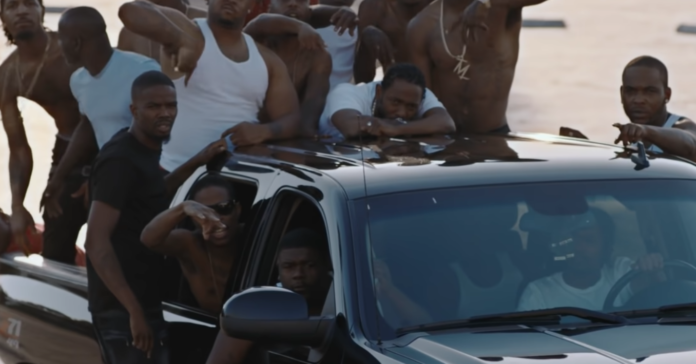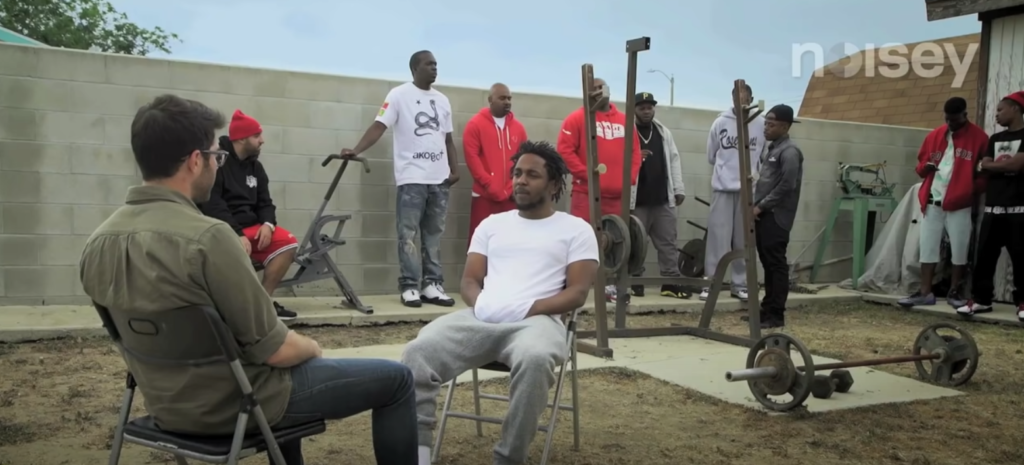Cause really I’m just a nigga that’s evil and spiritual
– Kendrick Lamar, “Poe Man’s Dream” (2011)
It’s important to simplify our understanding of Kendrick Lamar’s work when we get the chance. Not oversimplify, but damn, it’s rap! Lamar’s brilliance has prompted serious music listeners, often for worse, to find value in the most complex takes on what his art says. It’s the kind of behavior that turns a rebellious music genre into a “classic” and dusty one. And unlike previous rap legends whose images were based largely in criminality — no matter how respectable they later became — Kendrick’s rose-in-the-concrete narrative has kept people from acknowledging a simple yet very important part of who he is:
“I’m still a hood nigga, what you want me to do?”
– Jay Z in “3 Kings” (2013)
***
Kendrick shares responsibility in the prevailing idea of him as a mostly-innocent bystander who only made a few mistakes en route to surviving Compton. The title of his major label debut album says it all. While there’s truth in that view of him, Kendrick certainly doesn’t hide his involvement in — and deep attachment to — street vices and a cliché hood nigga mentality.
I’m diagnosed with real nigga conditions / Today is the day I follow my intuition / Keep the family close, get money, fuck bitches
– “YAH.” (2017)
If I gotta smack a pussy ass nigga I’ma make it look sexy
…
They won’t take me out my element
– “ELEMENT.” (2017)
If Kendrick Lamar’s exceptionalism is your primary view of him — the Pulitzer, the near-perfect Metacritic scores, the savior/golden child narrative — it often sounds abstract or satirical when he portrays himself doing rapper shit. Smacking people, fucking hoes, making threats, buying expensive cars. Not that Kendrick’s listeners are completely blind to his background, but those struggles aren’t Kendrick in the eyes of many. His shredding jazz raps and storytelling are genius. He has top-10 Billboard singles and #1 albums as a “conscious” rapper. The real Kendrick is the one on the mic and in those exquisite Little Homies music videos. Right?
Niggas thought that K.Dot real life is the same life they see on tv haaa?
– “ELEMENT.” (2017)
Mr. Morale and the Big Steppers is the type of album an artist with too many fans has to release. How many fans is too many fans? It’s not a number, it’s a moment: when the conversation about an artist’s work doesn’t even include the artist anymore.
Think Kanye West after My Beautiful Dark Twisted Fantasy. As early as 2009, Ye wanted fewer fans to lessen the commercial burden on his art. To this day, critics will drone on and on about how masterful and relevant Ye’s 5th solo LP is. If you have read even one MBDTF review, you can already see the liberal arts-educated writer clichés flying around in your head: “maximalist opus,” “Kubrick-esque,” “opulent,” “tHE tExtUReS.” The same people who lauded “All Of The Lights” as a feat of sonic and cultural engineering just watched him live out the song years later and parroted some sleazy gossip blog’s take on the matter. Once those people started driving the conversations about his work, Ye dropped Yeezus.
DAMN. is understood to be as close to a pop album as Kendrick Lamar got. By the time we received its lead single “HUMBLE.,” Lamar’s rep as a conceptual mastermind swept the discourse away. The reverse track list theories, the lectures on “symbolism” in YouTube comment sections, the Pulitzer Prize Board praising him for “vernacular authenticity.” It was all so snooty, the greatest joy being found in analysis instead of experience, speaking about the work instead of letting the work speak. In rap circles, DAMN. was hardly discussed in and of itself because we had to rank it in K.Dot’s discography a week after release. Its case as a classic album had to be decided by the summer.
Legacy talk is infuriating when the person building said legacy is clearly not finished. Just as annoying is Kendrick albums becoming Easter egg hunting events where people can’t keep their heads out of the bushes long enough to hear the grown-ups muttering about not-so-fanciful shit like divorces and crushing financial loss. Kendrick (oklama) has decided we’re old enough now, so the fun and games don’t exist on Mr. Morale and the Big Steppers.
Kendrick Lamar’s first three major label LPs were seismic events. The only things in 2010s hip-hop greater than Kendrick’s artistic ambition were his execution and Drake’s record sales. GKMC, TPAB, and DAMN. wrecked and rearranged the souls of rap fans for the better, each finding a unique way to have a heart-to-heart with Black America while selling to mainstream America. Largely, yes, Kendrick Lamar the artist could do no wrong. But somewhere in all the debates about GOATs and GRAMMYs and rap’s Mount Rushmore, we forgot Kendrick rapped with his real name. Meaning his raps had implications beyond the booth and our screens.
Meaning he cheated on his longtime partner a lot.
Meaning the good kid had a gun in his hand more often than we like to think:
I thought I found you back in the ghetto / when I was 17 with the .38 special
– “Momma” (2015)
I never was a gangbanger I mean I never was stranger to the funk neither / I really doubt it
– “The Art of Peer Pressure” (2012)
We was in the hood, 14 with the deuce-deuce / 14 years later goin’ hard like we used to
– “Hood Politics” (2015)
Meaning he doesn’t really know how to help Black people … he doesn’t even like the term “Black.”
“I’m an Israelite, don’t call me Black no mo’ / That word is only a color, it ain’t facts no mo'”
– “YAH.” (2017)
And God forbid you ask him for advice on how to respond to a Black-on-Black murder:
You should chip a nigga then throw the blower in his lap
– “XXX.” (2017)
The source of this generation’s most insightful bodies of work is not best understood as a rare genius that made it out the hood, though he is. Kendrick Lamar, as described by his own music, simply isn’t that clean. It’s more accurate and useful to view him as a man still in the hood — physically and spiritually — with common issues and uncommon will and skill to detail them for people.
Without downplaying his extraordinary craft and agency, the rarity of Kendrick Lamar’s work is not necessarily about the rarity of his life.
He’s one of countless Black men that has wished (and possibly caused) serious harm to another Black man. He’s one of countless Black men that had his eyes opened to Pan-Africanism as an adult. His self-awareness to his contradictions as a humanitarian and someone with “real nigga conditions” isn’t that unique. Nor is his version of the classic American tale of a Black man gaining a little money and fame then stepping out on his girlfriend with White women. Or suffering from survivor’s guilt. Or wiping tears with dollar bills.
So when someone this conflicted, this human, this normal, is willing to be hopeful after showing us how it all plays out in his life, we have to claim him as one of us. If a regular degular sinner from Compton can do that much for himself with words and sounds, what’s holding us back?
You can’t really categorize my music. It’s really just human music.
– Kendrick Lamar with Mina SayWhat of Power 99 on BET’s Music Matters Tour (September 2012)
***
What’s beautiful about the TPAB album cover is the love. The triumphant crowd of Black men and boys, mobbing with a dead judge at their feet, is looked at lovingly. Kendrick easily disappears into the scene if you’re not looking for him, as if to say these common Compton citizens made the album too. That the only key differences between him and them are time, commitment, and circumstance.
More often than people like to admit, Kendrick Lamar’s artistic viewpoint isn’t a bird’s eye or God’s omnipresence. He’s often right in the streets with his family and friends, or losing battles with the Devil that thousands of rappers before him have fought. Mr. Morale and the Big Steppers is a bare, daunting listen, but those who are tuned in are being rewarded. In case you haven’t been hearing him clearly enough, Kendrick has made sure everyone knows he is not above the issues he tackles in his music. That makes him an ordinary man from Compton, the foundation for his extraordinary art.

